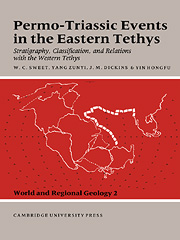 Permo-Triassic Events in the Eastern Tethys
Permo-Triassic Events in the Eastern Tethys Book contents
- Frontmatter
- Contents
- List of contributors
- Preface
- Acknowledgments
- 1 Permo-Triassic events in the eastern Tethys – an overview
- 2 Permo-Triassic boundary relations in South China
- 3 Permo-Triassic boundary of the Indian subcontinent and its intercontinental correlation
- 4 Permo-Triassic boundary on the Indian peninsula
- 5 The Permo-Triassic boundary in the southern and eastern USSR and its international correlation
- 6 Classification and correlation of nonmarine Permo-Triassic boundary in China
- 7 Permian and Triassic events in the continental domains of Mediterranean Europe
- 8 The Permo-Triassic boundary in the Southern Alps (Italy) and in adjacent Periadratic regions
- 9 Permo-Triassic brachiopod successions and events in South China
- 10 Conodont sequences in the Upper Permian and Lower Triassic of South China and the nature of conodont faunal changes at the systemic boundary
- 11 A conodont-based high-resolution biostratigraphy for the Permo-Triassic boundary interval
- 12 The palynofloral succession and palynological events in the Permo-Triassic boundary interval in Israel
- 13 The effects of volcanism on the Permo-Triassic mass extinction in South China
- 14 Geochemical constraints on the Permo-Triassic boundary event in South China
- 15 Permo-Triassic orogenic, paleoclimatic, and eustatic events and their implications for biotic alteration
- 16 Permo-Triassic boundary in Australia and New Zealand
- Index
4 - Permo-Triassic boundary on the Indian peninsula
Published online by Cambridge University Press: 12 October 2009
- Frontmatter
- Contents
- List of contributors
- Preface
- Acknowledgments
- 1 Permo-Triassic events in the eastern Tethys – an overview
- 2 Permo-Triassic boundary relations in South China
- 3 Permo-Triassic boundary of the Indian subcontinent and its intercontinental correlation
- 4 Permo-Triassic boundary on the Indian peninsula
- 5 The Permo-Triassic boundary in the southern and eastern USSR and its international correlation
- 6 Classification and correlation of nonmarine Permo-Triassic boundary in China
- 7 Permian and Triassic events in the continental domains of Mediterranean Europe
- 8 The Permo-Triassic boundary in the Southern Alps (Italy) and in adjacent Periadratic regions
- 9 Permo-Triassic brachiopod successions and events in South China
- 10 Conodont sequences in the Upper Permian and Lower Triassic of South China and the nature of conodont faunal changes at the systemic boundary
- 11 A conodont-based high-resolution biostratigraphy for the Permo-Triassic boundary interval
- 12 The palynofloral succession and palynological events in the Permo-Triassic boundary interval in Israel
- 13 The effects of volcanism on the Permo-Triassic mass extinction in South China
- 14 Geochemical constraints on the Permo-Triassic boundary event in South China
- 15 Permo-Triassic orogenic, paleoclimatic, and eustatic events and their implications for biotic alteration
- 16 Permo-Triassic boundary in Australia and New Zealand
- Index
Summary
Introduction
The Gondwana sequence of peninsular India is mainly terrestrial in nature and exhibits different patterns of sedimentation in each basin. This situation arose because deposition took place in linear, fault-bounded belts in which recurrent uplift or subsidence at varying rates created different tectonic regimes (Fig. 4.1). Consequently there are problems in interbasinal correlation. As a working system for correlation, however, various stratigraphic packages in a sequence are identified on the basis of lithic characters observed in discrete regions. These are then arrayed in a framework of greater spatial extent and this arrangement may be correlated precisely if biozones are available to use. However, biozones may or may not correspond with lithic units.
In recent years, a few widely spaced datum planes have been identified, along which biostratigraphic control matches well-delineated lithostratigraphic suites. The Permo-Triassic boundary has been one of the focal points for such an evaluation.
The conventional correlation of Gondwana formations is given in Fig. 4.2 (Datta & Mitra, 1982) and the Upper Permian–Lower Triassic interval is shown in greater detail in Fig. 4.3, which also includes information on general lithic characters. Some alterations based on recent data have been added.
The Upper Permian is characterized by diversification of the Glossopteris flora, which includes Glossopteris, Vertebraria, Raniganjia, Schizoneura, Tryzygia, Asansolia, and Damudopteris. The Lower Triassic flora records the advent of Dicroidium along with Lepidopteris, Podozamites, Macrotaenopteris, Pseudoctensis, and Pterophyllum. Palynologically, the Upper Permian assemblage is dominated by striate disaccate pollen (Striatopodocarpites, Faunipollenites, Crescentipollenites, Striatites, etc.) and qualifying taxa (Densipollenites, Gondisporites, Thymospora, Guttulapollenites, Indospora, etc.). On the other hand, the Lower Triassic assemblage is composed mainly of Klausipollenites, Lunatisporites, Lundbladispora, Densoisporites, Callumispora, Verrucosisporites, Playfordiaspora, Alisporites, and Satsangisaccites.
- Type
- Chapter
- Information
- Permo-Triassic Events in the Eastern TethysStratigraphy Classification and Relations with the Western Tethys, pp. 37 - 45Publisher: Cambridge University PressPrint publication year: 1992
- 3
- Cited by


